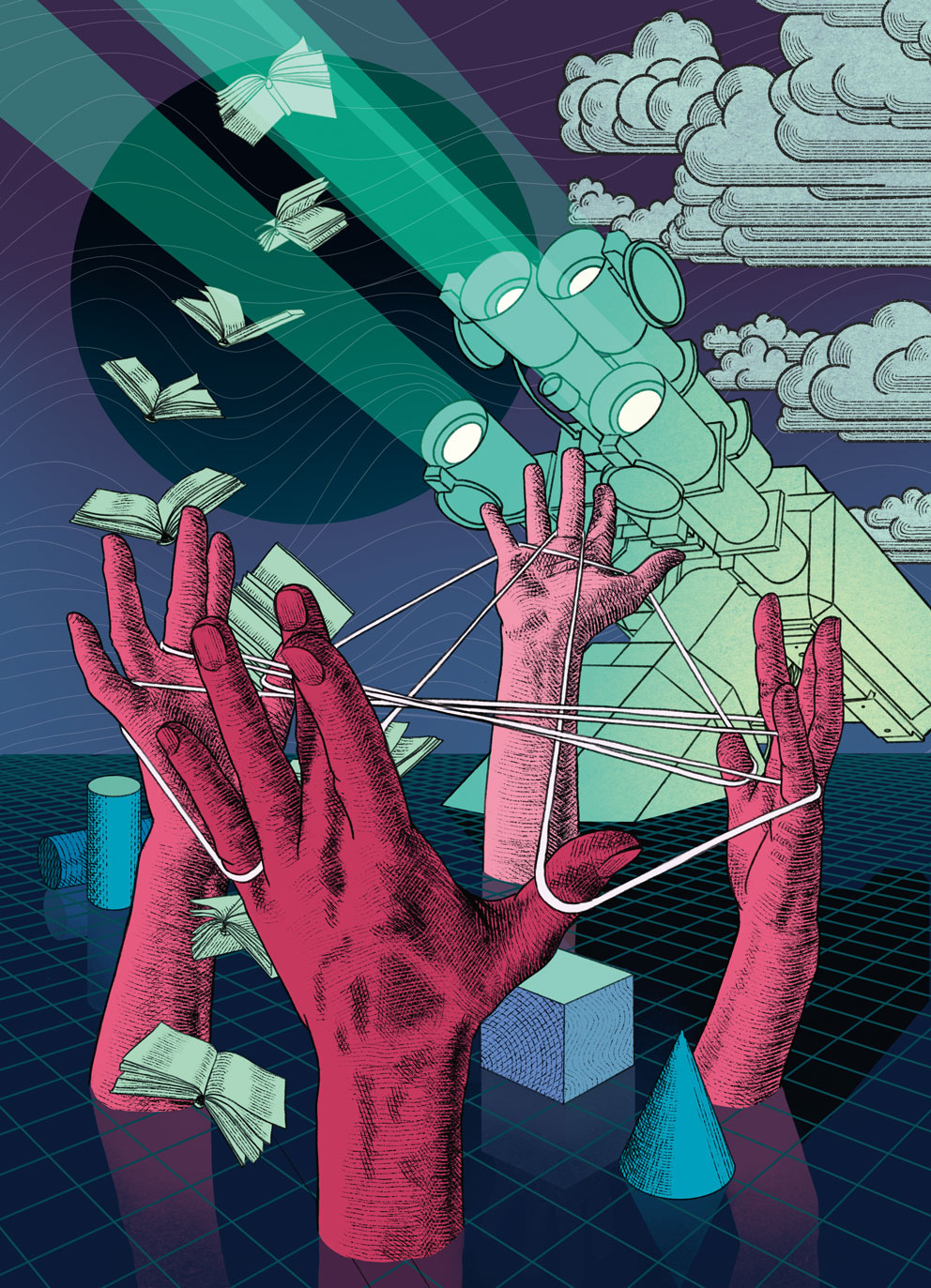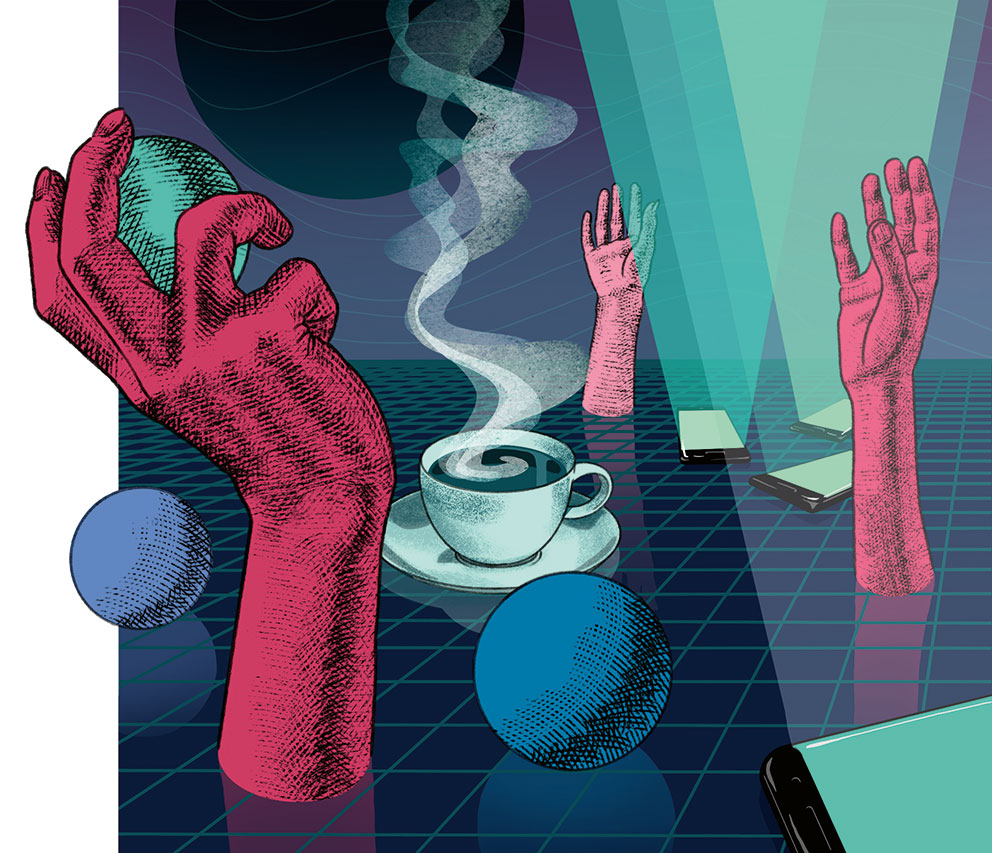Jump to the content
- {{#headlines}}
- {{title}} {{/headlines}}

When Alexander von Humboldt contemplated the view of the Andes from Chimborazo in June 1802, he started to see the world through different eyes. “The Earth seemed to him like a huge organism in which everything was linked with everything else,” is the way in which the Humboldt biographer, Andrea Wulf, describes it. Humboldt’s holistic view of nature revolutionised science; today, we know indisputably that individual cells are connected – they interchange and communicate with one another via subterranean mycelia, creating networks of entire ecosystems.
Since then, the notion of the network has established a unique place for itself. Whether we think of neural networks, the internet or social networks, in the second half of the 20th century, the network became a universal metaphor. According to the cultural scholar, Hartmut Böhme, from Humboldt-Universität of Berlin, this was a result of “the paradigm shift from physics to biology and from sociology to computer science that caused not just living biological systems but, above all, information-based control and communication networks to become the focus of scientific attention.”
Networks can cross borders and break open supposedly hermetically sealed entities. As the Humboldt Foundation’s global academic network shows, they forge connections across disciplines, institutions and nations.
“Are new technologies obviating the need for climate-damaging air travel to conferences and research visits?”
On this point, encounters with people from cultures other than our own are particularly fruitful. At the latest since the publication of the influential essay, “The Strength of Weak Ties”, by the American sociologist and network theoretician, Mark Granovetter, in the 1970s, we know that in networks, the especially productive contacts are those that come about between people who previously had little or nothing to do with each other. Whilst proximity means that we tend to share the same information within our inner circle, which leads to uniform ways of thinking, outside influences generate new ideas.
Weak ties, strong ideas
There are plenty of examples of the strength of these “weak ties” in the Humboldt Network, too. Holger Schönherr, for example, professor of physical chemistry at the University of Siegen, got talking to the junior researcher, Nowsheen Goonoo, from Mauritius at a conference in South Korea in 2013. Both researchers discovered that they were using similar classes of materials and methods. “We were both immediately struck by the very promising synergic effects of combining polyesters with polymers on the basis of indigenous renewable raw materials for biomedical applications,” says Professor Schönherr. This personal encounter engendered several research collaborations during which Nowsheen Goonoo came to Siegen. Whilst the Siegen scientists’ research on biodegradable nanomaterials benefitted from Goonoo’s material expertise on the indigenous Mauritian plants, aloe vera and brown seaweed, the visiting researcher from the small island state in the Indian Ocean was able to acquire experience working with an atomic force microscope.

Another win-win situation is the cooperation between Nicole Wrage-Mönnig from the University of Rostock and the Georg Forster fellow, Chabi Djagoun, from Benin. This contact also came about through the Humboldt Network. Whilst the ecologist from Africa made the Rostock research group rethink what were seemingly self-evident assumptions about photosynthesis, for instance, he himself was able to use the isotope ratio mass spectrometry facilities in the Department of Grassland and Fodder Sciences to investigate which plants feed the common tsessebe, a species threatened with extinction in his own country.
“The public nature of digital networks is the key to more diversity.”
What many members of the Humboldt Family experience for themselves is not only confirmed by the Foundation’s evaluations, but also by work like that of Caroline S. Wagner, professor of international relations at Ohio State University, United States. She explores the relationship between a country’s science system and its politics and society. Together with Koen Jonkers from the University of Cambridge, United Kingdom, she studied 36 countries’ publication and citation data. The outcome was that the strength of a country’s science, calculated according to publication numbers, citation frequency and co-authorship, correlates with its willingness to host international researchers. “The more people travel and exchange ideas, the more a country benefits. The more open a country is through exchange, the more scientifically important and influential it becomes,” Caroline S. Wagner summarises. So, researcher mobility helps networks and countries to meet the challenges posed by the future. But to what extent do researchers in a digitised world really need to be in the same place at the same time in order to work together and benefit from one another? Are new technologies obviating the need for climate-damaging air travel to conferences and research visits?
Digital networks are more open
“Physical and virtual mobility should not stand in binary opposition to one another. The challenge is to discover how both can be practised best in the highly flexible, dynamic meshwork of interlocking networks so that the knowledge we need for the future can be produced. In new, multi-dimensional networks, this knowledge should be understood as a structure, not a personal good. It is up to all of us to create the ‘Humboldt Network 4.0’,” is the appeal voiced by Hans-Christian Pape, President of the Humboldt Foundation.
The American microbiologist, Beronda Montgomery, has addressed the question of how social media and digital platforms can be used to create sustainable, functioning networks. She herself is also active in digital networks: “Over the past three to four years, I have been actively engaged in a number of groups on Twitter, networks of support, networks of mentoring. Some of those are disciplinary, others are things like #BLACKandSTEM which is a community to support African Americans in the sciences,” Montgomery reports. She thinks the major advantage of digital networks is quite simply how open they are. “So, I think the public nature of networks is integral to their inclusivity because they allow individuals who are simply scanning for resources to connect with a community that they may not have otherwise found and had access to. But I think as well, it allows people who may not be members of a certain identity group to listen in to topics of interest or perhaps be an advocate for these groups,” says Montgomery.
“Physical and virtual mobility should not stand in binary op- position to one another. The challenge is to discover how both can be practised best in the highly flexible, dynamic meshwork of interlocking networks so that the knowledge we need for the future can be produced. In new, multidimensional networks, this knowledge should be understood as a structure, not a personal good. It is up to all of us to create the ‘Humboldt Network 4.0’”
Looked at historically, novel networks are usually linked to technological developments. This also holds true for the world of science and especially its digital networks. The digital science platforms ResearchGate and Academia.edu, for example, have more than 15 and 108 million registered users respectively. According to ResearchGate, some 10,000 researchers, who are merely required to state to which institution they are affiliated when they register, log on every day. They want to contact each other and gain access to the papers that are available so quickly there because they do not have to go through the protracted editing and redacting processes at a publisher’s. A broad mass of users has easy access to specialist knowledge that it can continue processing. A new framework thus emerges in which knowledge is exchanged and generated. This virtual mobility of knowledge changes the form of the knowledge itself.
Fast knowledge transfer
Other methods, such as crowdreviewing, which the Humboldt Foundation also embraces, utilise the opportunities offered by digitisation – in this case to unburden the review process and make it more flexible. It would also be good for the climate if not only knowledge, but also researchers were more frequently connected with one another virtually. “I attended a couple of conferences over Twitter this past year to reduce my carbon footprint.

Still being able to participate in these spaces is one positive outcome of digital platforms like these, but they are also reaching a wider audience by lowering some of the economic and ecological barriers to engaging in knowledge exchange,” Beronda Montgomery believes. She now feels quite happy about holding seminars online. What gets lost, however, are the informal conversations over coffee or dinner, the American emphasises. And these are so very productive, Caroline S. Wagner confirms and adds that, in her own research, she found that close to 90 percent of the collaborations began face-to-face in some way.
Last year, more than 1,700 researchers in Germany signed a petition committing to abstaining from air travel on business trips of less than 1,000 kilometres.
“Ninety percent of my collaborations began face-to-face.”
Whilst organisations can consider sending only some representatives to conferences by air, who can represent their organisations and later act as multipliers, even the experts do not doubt the sense and purpose of research visits – despite climate change. One reason for this is that these offer different ways of accessing explicit and tacit knowledge, a concept attributed to the philosopher, Michael Polanyi.
Explicit knowledge denotes knowledge that can be clearly formulated and reproduced; tacit knowledge, on the other hand, always has a personal quality. Explicit knowledge, such as an online presentation at a conference or a webinar at university, can easily be communicated using digital means or, in some cases, via digital platforms. In order to learn and apply tacit knowledge like tried and tested research practices, it is necessary for individuals to be physically present in a different research environment. Only by experiencing a trusting relationship with senior researchers can young scientists and scholars learn from their way of working, methods and informal practices and thus also form unexpected linkages.
“Networks only ever exist as networks within networks,” Hartmut Böhme has observed. So, today’s researchers have long been involved in many networks at the same time, both analogue and digital. They and their knowledge must be able to circulate, digitally and analogously. Travel, especially by air, will become less frequent, let us venture to predict. But it will not often be possible to find a substitute for personal encounters.
published in Humboldt Kosmos 111/2020
